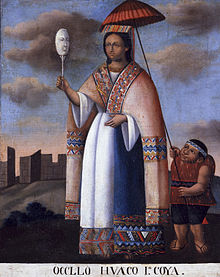| Mama Ocllo | |
|---|---|
Motherhood and Fertility | |
 Mama Ocllo, anonymous oil on canvas painting from Peru, circa 1840, San Antonio Museum of Art. | |
| Other names | Mama Cora Ocllo,[1] Mama Ogllo, Mama Oello,[2] Mama Oella, Mama Oullo, Mama Occlo,[3][4] Mama Okllo or Mama Uqllu.[5] |
| Genealogy | |
| Parents | Inti and Mama Killa or Viracocha and Mama Qucha |
| Siblings | Ayar Uchu, Ayar Cachi, Ayar Anca, Manco Cápac, Mama Huaco, Mama Ipacura, and Mama Raua |
| Consort | Manco Cápac |
| Offspring | Sinchi Roca |
In Inca mythology, Mama Ocllo, or more precisely Mama Uqllu, was deified as a mother and fertility goddess.[6] In one legend she was a daughter of Inti and Mama Killa, and in another the daughter of Viracocha (Wiraqucha) and Mama Qucha.[7] In all of them she was the older sister and wife of Manco Cápac (Manqu Qhapaq),[8]: 28–36 whom she established the city of Cusco with.[9][10] In some variations, she also had a son with him, Sinchi Roca, though all Incan rulers after Manco Cápac were believed to be their descendants.[11][12]
According to most stories, Mama Occlo and Manco Cápac were sent by Inti to help the Inca by expanding their knowledge after he saw how poorly they were living.[13] After their creation, most legends state, they began journeying to find the perfect location to begin their task, and would know when they had found it when the golden rod Inti had given both his children sank into the ground.[11][14] Once the rod had sunk, they began educating the Inca people; together they taught the people to better construct homes; Mama Ocllo taught the Inca women the art of spinning thread, sewing, and household duties.[11][14][15]
- ^ "EL PRIMER NVEVA CORÓNICA". Archived from the original on 2011-07-20.
- ^ Bancroft, byHubert Howe (1980). The works of Hubert Howe Bancroft the native races : vol. IV, antiquities. San Francisco: A.L. Bancroft. p. 296. ISBN 0665141556.
- ^ Edwardes, Marian (1912). A dictionary of non-classical mythology. London: J.M. Dent & Sons. p. 113.
- ^ Bingham, Ann (2004). South and Meso-American mythology A to Z. New York: Facts on file. p. 79. ISBN 0816048894.
- ^ Dean, Carolyn (2010). A culture of stone : Inka perspectives on rock. Durham, NC: Duke University Press. p. 88. ISBN 9780822347910.
- ^ Siquijor, Rom (5 January 2012). Inkari: the Sacred Prophecy of the Inca Kings. [S.l.]: Palibrio. ISBN 978-1617648731.
- ^ Bingham, Ann (2004). South and Meso-American mythology A to Z. New York: Facts on file. p. 68. ISBN 0816048894.
- ^ de Gamboa, P.S., 2015, History of the Incas, Lexington, ISBN 9781463688653
- ^ Julien, Catherine (2000). Reading Inca history. Iowa City: University of Iowa Press. p. 64. ISBN 9781587294112.
- ^ Coulter, Charles Russell; Turner, Patricia (2000). Encyclopedia of ancient deities. Jefferson, N.C.: McFarland. p. 304. ISBN 9780786403172.
- ^ a b c "The Life of Pachacuti Inca Yupangui." Bilingual Review, vol. 26, no. 2-3, 2001, p. 149+. Academic OneFile.
- ^ "The Rise of the Incas." Early Civilizations in the Americas Reference Library, edited by Sonia G. Benson, et al., vol. 1: Almanac, Vol. 1, UXL, 2005, pp. 155-177. Student Resources In Context.
- ^ Feld, Evelyn Dana. "The Inca Creation Myth." Calliope, Mar. 2000, p. 36. General OneFile.
- ^ a b Editors of Salem Press. Critical Survey of Mythology and Folklore : World Mythology. Salem Press, 2013. EBSCOhost.
- ^ Stanton, editors: Janet Parker, Julie (2006). Mythology : myths, legends & fantasies. Cape Town, South Africa: Struik. p. 505. ISBN 1770074538.
{{cite book}}:|first=has generic name (help)CS1 maint: multiple names: authors list (link)